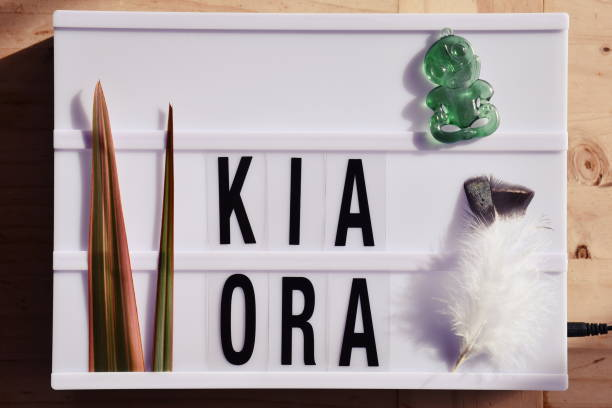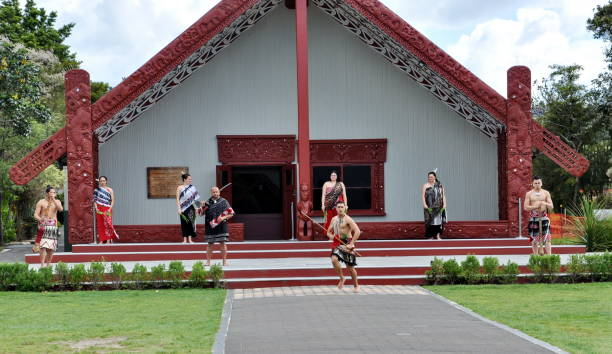Māori greetings hold significant cultural importance in New Zealand, providing a beautiful insight into the language and etiquette of the indigenous Māori people. This article delves into the basics of Māori greetings, popular phrases, and their appropriate contexts. Whether you are preparing for a visit, studying at a university with a diverse cultural tapestry, or simply interested in expanding your linguistic horizons, understanding these greetings is a fantastic starting point.
Understanding the Significance of Māori Greetings
Māori greetings are more than just words exchanged; they are a reflection of respect and community values. These greetings often convey the speaker’s intentions, the relationship between the speakers, and the context of their meeting. Here’s a closer look at why these greetings are pivotal:
- Cultural Identity: They affirm the Māori identity and heritage.
- Respect: Using Māori greetings shows respect and appreciation for Māori culture.
- Inclusion: Incorporating Māori phrases in daily conversations promotes inclusiveness.
Common Māori Greetings and Phrases
Here is a table of common Māori greetings you might encounter or wish to use, along with their English translations:
| Māori Greeting | English Translation |
| Kia ora | Hello, Good health |
| Tēnā koe | Greetings to you (one person) |
| Tēnā kōrua | Greetings to you two |
| Tēnā koutou | Greetings to you all |
| Haere mai | Welcome |
| Nau mai | Welcome |
| Kei te pēhea koe? | How are you? |
| Kei te pai | I am good |
| Mōrena | Good morning |
| Ata mārie | Good morning (more formal) |
| Pō mārie | Good night (formal) |
Understanding and appropriately using Māori greetings not only demonstrates respect for the culture but also fosters positive interactions. Here’s a detailed guide on how to use three common Māori greetings:
Kia ora
Kia ora is one of the most versatile Māori greetings. It can be used in various contexts, making it suitable for any time of the day.
- Morning: “Kia ora, how are you today?”
- Afternoon: “Kia ora, have you had lunch yet?”
- Evening: “Kia ora, hope you’re enjoying your evening.”
While Kia ora is generally used as a greeting, it can also express gratitude or appreciation. For instance, “Kia ora for your help” means “Thank you for your help.”
Tēnā koe
Tēnā koe is used when addressing a single person. It carries a formal tone and is commonly used in respectful or ceremonial settings.
- Meeting someone for the first time: “Tēnā koe, it’s a pleasure to meet you.”
- Expressing gratitude: “Tēnā koe for your assistance.”
- Acknowledging someone’s presence: “Tēnā koe, welcome to the gathering.”
Tēnā koe is typically followed by a short pause, allowing for acknowledgement or response from the recipient.
Haere mai and Nau mai
Both Haere mai and Nau mai translate to ‘welcome.’ They are used interchangeably when receiving guests, visitors, or newcomers.
- Welcoming guests: “Haere mai, come on in and make yourself at home.”
- Inviting someone to enter: “Nau mai, please join us for the celebration.”
- Extending hospitality: “Haere mai, we’re delighted to have you here.”
Haere mai and Nau mai are often accompanied by gestures such as open arms or a welcoming smile to enhance warmth and sincerity.
Etiquette Tips for Using Māori Greetings
To enhance your interactions using Māori greetings, consider these etiquette tips:
Pronunciation
Proper pronunciation is fundamental when using Māori greetings. It demonstrates respect for the language and its speakers. Here are some key pronunciation guidelines for common Māori greetings:
| Māori Word | Pronunciation |
| Kia ora | kee-ah or-ah |
| Tēnā koe | tay-nah koh-eh |
| Haere mai | high-reh my |
| Mōrena | more-eh-nah |
Practicing these pronunciations ensures that you convey your greetings accurately and respectfully.
Context Matters
Understanding the appropriate context for using Māori greetings is essential. They are often used in informal settings and may not always be suitable for formal occasions. Here are some common contexts where Māori greetings are appropriate:
- Informal Gatherings: Māori greetings are commonly used among friends, family, and acquaintances in casual settings.
- Cultural Events: They are frequently used at cultural events, such as powhiri (traditional Māori welcome ceremonies) or marae (Māori meeting grounds).
- Workplaces: In some workplaces with a strong emphasis on Māori culture, using Māori greetings can be appropriate, but it’s essential to gauge the workplace culture and norms first.
Reciprocity and Response
When someone greets you using a Māori greeting, it’s customary to reciprocate the greeting. Here are some common responses:
- Kia ora: If someone says “Kia ora” to you, you can respond with “Kia ora” or “Tēnā koe” (if you want to acknowledge the individual).
- Tēnā koe: When greeted with “Tēnā koe,” you can respond with “Tēnā koe” or “Kia ora” to reciprocate the greeting.
Reciprocity fosters positive interactions and demonstrates cultural understanding and respect.
Gesture and Eye Contact
Accompanying Māori greetings with appropriate gestures and maintaining eye contact adds sincerity and warmth to your interaction. When offering a Māori greeting:
- Smile: A genuine smile conveys warmth and friendliness.
- Handshake or Hongi: Depending on the situation and your comfort level, you may accompany the greeting with a handshake or a hongi (traditional Māori greeting where noses are pressed together).
Gestures should be respectful and culturally appropriate.
Continued Learning
Embracing Māori greetings is an ongoing journey of learning and cultural appreciation. Take the initiative to learn more about Māori language and customs to deepen your understanding and respect. Resources such as language classes, cultural workshops, and online materials can be invaluable in expanding your knowledge.
Māori Greetings at Universities

In an educational context, particularly at universities that embrace cultural diversity, Māori greetings are becoming increasingly prevalent. Here’s how they’re integrated:
Official Correspondence
Universities often initiate official correspondence, such as emails and announcements, with Māori greetings. This practice not only demonstrates respect for Māori culture but also serves as a reminder of the rich cultural tapestry that shapes New Zealand society. Including Māori greetings in official communications also contributes to the normalization of indigenous languages in academic settings, promoting linguistic diversity and cultural awareness.
Example of Māori Greetings in Official Correspondence:
| English Translation | Māori Greeting |
| Hello/Hi | Kia ora |
| Dear [Name] | Tēnā koe |
| Regards/Best wishes | Ngā mihi |
Lectures and Meetings
In academic gatherings such as lectures, seminars, and meetings, it is increasingly common to begin with a Māori greeting. This practice acknowledges the traditional custodians of the land on which the university stands and pays respect to Māori ancestors, known as tūpuna. By incorporating Māori greetings into these settings, universities demonstrate a commitment to honoring indigenous cultures and fostering a sense of unity and respect among attendees.
Examples of Māori Greetings in Lectures and Meetings:
- At the beginning of a lecture: “Kia ora koutou, nau mai, haere mai ki te whare wananga. Welcome everyone, please be seated.”
- In a meeting: “Tēnā koutou katoa, let us begin our meeting with a moment of reflection and gratitude for the land we gather on.”
Cultural Events
During special occasions such as Māori Language Week or cultural festivals, universities often organize events to celebrate Māori culture. These events may include workshops, performances, and language lessons aimed at promoting the understanding and appreciation of Māori traditions. Māori greetings play a central role in these events, providing attendees with an opportunity to engage with the language and customs of the indigenous people of New Zealand.
Example of Māori Greetings in Cultural Events:
- During Māori Language Week: “Nau mai, haere mai ki te wiki o te reo Māori! Welcome to Māori Language Week! Let’s celebrate the beauty and richness of the Māori language together.”
- At a cultural festival: “Kia ora whānau! Welcome to our celebration of Matariki, the Māori New Year. Let’s honor this special time with song, dance, and fellowship.”
Practical Applications of Māori Greetings
Incorporating Māori greetings into everyday life can be enriching and respectful. Here are some scenarios where you can use these greetings:
In Emails
Starting your emails with a Māori greeting is a simple yet meaningful way to acknowledge and respect the recipient. This practice adds a cultural touch to your communication and sets a positive tone for the exchange. Incorporating Māori greetings into emails demonstrates cultural awareness and appreciation, enhancing the relationship between sender and recipient.
Example of Māori Greetings in Emails:
| English Translation | Māori Greeting |
| Hello/Hi | Kia ora |
| Dear [Name] | Tēnā koe |
| Regards/Best wishes | Ngā mihi |
Using Māori greetings in emails not only shows respect for the recipient but also contributes to the normalization of indigenous languages in digital communication.
In Meetings
Opening or closing meetings with a Māori greeting is a respectful way to acknowledge cultural diversity and honor the indigenous heritage of New Zealand. Whether it’s a formal boardroom meeting or a casual team gathering, incorporating Māori greetings sets a tone of inclusivity and respect. Using Māori greetings in meetings fosters a sense of unity and respect among participants while recognizing the cultural significance of the land on which the meeting takes place.
Examples of Māori Greetings in Meetings:
- At the beginning of a meeting: “Kia ora koutou, let us begin our meeting by acknowledging the traditional custodians of the land.”
- At the end of a meeting: “Ngā mihi nui ki a koutou, thank you all for your contributions today. Let’s close with a moment of reflection and gratitude.”
Incorporating Māori greetings into meetings not only acknowledges cultural diversity but also creates an inclusive environment conducive to productive discussions and collaborations.
In Social Interactions
Using Māori greetings in casual conversations adds a personal and cultural dimension to social interactions. Whether greeting friends, colleagues, or acquaintances, incorporating Māori greetings can deepen connections and foster a sense of belonging. Using Māori greetings in social interactions demonstrates cultural respect and appreciation, contributing to a more inclusive and culturally diverse society.
Examples of Māori Greetings in Social Interactions:
- When meeting someone: “Kia ora! How are you today?”
- In farewell: “E noho rā, take care until we meet again.”
By incorporating Māori greetings into everyday social interactions, individuals contribute to the promotion and preservation of Māori language and culture, fostering greater understanding and respect within the community.
Conclusion
Māori greetings are a window into the vibrant culture and traditions of New Zealand’s indigenous people. By embracing these greetings, you contribute to preserving and respecting Māori heritage. Whether you’re a student, a professional, or a visitor, integrating Māori greetings into your communication is not only respectful but also enriches your interactions with a touch of New Zealand’s unique cultural identity.
FAQ
A: Absolutely! Using Māori greetings shows respect and appreciation for Māori culture. It’s encouraged to use them.
A: Very important. Pronouncing Māori words correctly respects the language’s integrity and its speakers.
A: Yes, Māori greetings are appropriate in both casual and formal settings, including professional environments.
A: It’s okay to ask. Most Māori speakers appreciate the effort and will help you understand the proper usage and pronunciation.
